February 11th, 2016
 When it comes to your social and professional life, teeth can make a big difference. That’s why we’re focused on making your smile as beautiful as possible. Over the years, we’ve become known as the top cosmetic dentistry in Chicago for our work on pearly whites. Here are a few of our most popular teeth treatments in Water Tower Place, Chicago and why so many people love them.
When it comes to your social and professional life, teeth can make a big difference. That’s why we’re focused on making your smile as beautiful as possible. Over the years, we’ve become known as the top cosmetic dentistry in Chicago for our work on pearly whites. Here are a few of our most popular teeth treatments in Water Tower Place, Chicago and why so many people love them.
Invisalign Clear Braces
Traditional braces are so five years ago. But really, why wear annoying, obtrusive and unattractive traditional braces when you can wear invisible braces? Invisalign has become one of our most popular dental treatments because of how easy and transparent it is. Just like traditional braces, Invisalign straightens out your teeth over time. But it does this with clear aligners that can easily be removed whenever you’d like. Learn how Invisalign can fix your underbite too! Take a look at our before and after Invisalign photos here.
Teeth Whitening
There’s a reason most celebrities have shiny white teeth. Whether it makes sense or not, pearly whites make you look young, healthy and successful. We have a ton of patients come through our offices for Zoom! Teeth Whitening because it can make your teeth up to ten shades whiter after just one single one-hour treatment. Fast, effective and long lasting, you can’t beat Zoom! when it comes to teeth whitening. We also offer take home teeth whitening trays if you prefer your couch to the dental chair.
[caption id="attachment_2288" align="aligncenter" width="604"] A Water Tower Dental Care patient before and after Invisalign, teeth whitening and dental veneers.[/caption]
A Water Tower Dental Care patient before and after Invisalign, teeth whitening and dental veneers.[/caption]
Dental Veneers
Mask your teeth imperfections with dental veneers! Veneers are so popular because they successfully cover up a variety of different teeth problems, including stains, odd shapes, chips, big spaces, and crooked teeth. Whether Mother Nature didn’t give you the teeth of your dreams, or injury or age has left you with teeth you don’t recognize, veneers can be carefully placed onto your teeth to perfect issues. Check out our before and after porcelain veneers photo gallery!
Carefully designed for your mouth, more permanent porcelain veneers are best for severe dental issues, while minimal prep veneers are the better choice for those who have smaller problems and/or less time. Find out which type of veneer is best for you here.
CEREC One Visit Crowns
Traditionally, it took at least two visits and countless hours to fit, create and place dental crowns. With CEREC One Visit Crown technology, crowns can be perfectly customized and placed to match your teeth in just one hour. You can see why this treatment has become one of our most popular. Take a look at Water Tower Dental patients before and after CEREC One Visit Crowns. Learn more about fixing a broken tooth with CEREC One Visit Crowns here!
These are our most popular cosmetic dental treatments for a reason: they make your smile look better than ever while saving you time! Contact us to learn more about the treatments our office in Water Tower Place, Chicago offers.
Tags: cerec, CEREC one-visit crowns, chicago, cosmetic dental veneers, crowns, dental veneers, invisalign, invisalign braces, porcelain veneers, teeth whitening, veneer, water tower dental, water tower dental care, Zoom! Teeth Whitening
Posted in The Dentist Recommends | No Comments
February 6th, 2014
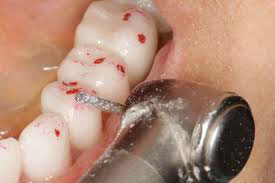 If you are experiencing, headaches, ear problems, clicking or grating jaw, mouth discomfort, and looseness of teeth, or any combination of these symptoms, you may be having an issue with your TMJ. If that’s the case, your dentist might recommend occlusal adjustments. What are occlusal adjustments? It is a method to reshape the surface of your teeth to create an even and harmonious relationship between the top and bottom teeth. To understand why this needs to happen though, we must dig a little deeper.
If you are experiencing, headaches, ear problems, clicking or grating jaw, mouth discomfort, and looseness of teeth, or any combination of these symptoms, you may be having an issue with your TMJ. If that’s the case, your dentist might recommend occlusal adjustments. What are occlusal adjustments? It is a method to reshape the surface of your teeth to create an even and harmonious relationship between the top and bottom teeth. To understand why this needs to happen though, we must dig a little deeper.
As you may have read in our earlier blog post, we described the condition known as TMD, or Temporomandibular Joint Disorder. This is a condition in which the TMJ, or Temporomandibular Joint, is slightly displaced. This is a very delicate and complicated joint that helps move your jaw. When you stick your chin forward, or side-to-side, the mandible joint slides out of its socket. When your chin and jaw are centered and pulled back, the mandible sits in the sockets of the joint. the TMJ is designed to rest in the sockets of the joint rather than displaced forward or to the side. However, if your teeth are not aligned to the proper positions, then closing your mouth can cause a shift in the joint, which adds unnecessary stress to the mouth and jaw.
If your TMJ is misplaced, then the symptoms we mentioned earlier, plus more can begin to occur. You can wake up in the morning with headaches, pain behind the eyes, swollen throat, sore neck and more. Most telling, when you wake up, you might not be able to move your mouth or jaw and have trouble opening up your mouth to eat. If this sounds like a situation you have experienced before, you should consult a dentist immediately.
So what will happen at the dentist? If you do happen to have TMD, your dentist will want to make occlusal adjustments to better align your teeth so your mandible can rest correctly in its socket using Tek scan technology. This includes finding the teeth’s positions in the mouth and the proper areas to make the adjustment. Much like trimming your hair or fingernails, only very small amounts of the teeth are shaved down to create an evenly centric relation. With that, you should experience less teeth grinding and your jaw should sit more centered relieving any kind of discomfort.
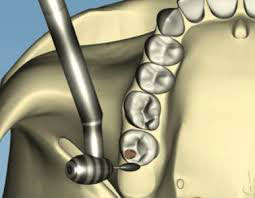 While shaving down teeth can seem like an easy option, it’s an irreversible procedure, and if the adjustments aren’t made properly, you could find yourself in a troubling situation. At Water Tower Dental, we offer non-damaging therapy options that can help fix the TMD condition. Using a Transcutaneous Electrical Neural Stimulation, or TENS, unit, we are able to asses any neuromuscular problems. While many doctors focus on the misplacement of the jaw, scientific developments have revealed that some problems associated with teeth, mouth, and jaws are actually caused by improper functions of the muscles and nerves. Using the TENS unit, we are able to find ideal positioning of the jaw.
While shaving down teeth can seem like an easy option, it’s an irreversible procedure, and if the adjustments aren’t made properly, you could find yourself in a troubling situation. At Water Tower Dental, we offer non-damaging therapy options that can help fix the TMD condition. Using a Transcutaneous Electrical Neural Stimulation, or TENS, unit, we are able to asses any neuromuscular problems. While many doctors focus on the misplacement of the jaw, scientific developments have revealed that some problems associated with teeth, mouth, and jaws are actually caused by improper functions of the muscles and nerves. Using the TENS unit, we are able to find ideal positioning of the jaw.
With the information gathered, we can begin properly adjusting the jaw to relieve discomfort. We recommend patients to wear an orthotic for three months, afterward, we can determine if the orthotic has alleviated the symptoms or if further adjustments are necessary.
Much of TMD is trial and error; all patients’ jaws and muscles react different to orthotics and natural adjustments. However, we do believe using non-damaging methods first is the best option. While occlusal adjustments may have worked in the past, there are too many cases in which damage has been done without proper results.
If you are having symptoms of TMD and would like to talk to Water Tower Dental on how you can fix the issue without irreversible procedures, contact us today.
October 10th, 2013
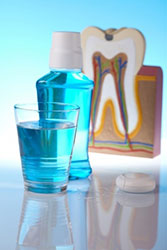 If you're looking for that extra step in oral hygiene to help kill bacteria and freshen breath, look no further than mouthwash. There are three leading types of mouthwash that all serve different purposes depending on your needs. Here's a helpful guide to educate you on what you should look for in a mouthwash and why.
If you're looking for that extra step in oral hygiene to help kill bacteria and freshen breath, look no further than mouthwash. There are three leading types of mouthwash that all serve different purposes depending on your needs. Here's a helpful guide to educate you on what you should look for in a mouthwash and why.
Mouthwashes are a great tool for proper oral hygiene, however, cannot replace brushing and flossing which are essential to teeth care. While mouthwash can help both free the mouth of food particles and kill bacteria, it does not have the same strength and brushing and flossing. That is because mouthwash does not have the abrasive scrubbing power of either a toothbrush or floss.
Mouthwash works by a round of bacteria-fighting chemicals, usually different depending on the brand of mouthwash. However, the main ingredient for a successful mouthwash comes from a chlorhexidine compound, which helps prevent plaque build up. Mouthwashes before chlorhexidine did not stay long enough in the mouth to do any successful fighting of plaque and bacteria. In the 1960s, though, it was discovered that chlorhexidine was able to adhere to the teeth and help fight plaque for many hours. Since then, a range of commercial brands have released their version of the mouthwash, all with a chlorhexidine compound.
There are three main types of mouthwash which each serve slightly different functions, while all still helping fight plaque.
The first type of mouthwash is the Antibacterial mouthwash. These types of mouthwashes are helpful in fighting gum disease, gingivitis, plaque, along with reducing the bacteria count by 75 percent. Antibacterial formulas are typically high in alcohol content and can often come with a small burning sensation when used. With a strong flavor, many find antibacterial mouthwashes slightly uncomfortable, but highly effective. If the alcohol in mouthwash is a nuisance to a consumer, however, there are several alcohol-free versions of the same brands you can try.
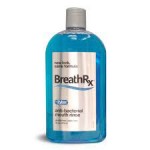 The next type of mouthwash is a Breath-Freshening mouthwash. The kinds of mouthwashes are typically made with a much lower alcohol content than the antibacterial mouthwashes. Rather, these mouthwashes have higher counts of chlorine or zinc which are helpful in defusing the sulphur compounds which are the leading cause of bad breath. While, these kinds of mouthwashes do have a stronger focus on breath, they still have the ability to fight bacteria. The compound cetylpyridinium is often present in many of these mouthwashes, which helps fight bacteria and plaque.
The next type of mouthwash is a Breath-Freshening mouthwash. The kinds of mouthwashes are typically made with a much lower alcohol content than the antibacterial mouthwashes. Rather, these mouthwashes have higher counts of chlorine or zinc which are helpful in defusing the sulphur compounds which are the leading cause of bad breath. While, these kinds of mouthwashes do have a stronger focus on breath, they still have the ability to fight bacteria. The compound cetylpyridinium is often present in many of these mouthwashes, which helps fight bacteria and plaque.
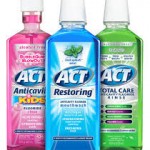 The last type of mouthwash is a Fluoride-Based rinse. These mouthwashes are very specific to anti-cavity and prevention. Fluoride is known to help protect and strengthen tooth enamel, which in turn protect the teeth from harmful decay. While many mouthwashes can contain fluoride, there are specific mouthwashes that have a much higher content of fluoride then any other anti-bacterial compound. With these kinds of mouthwashes, the user must be very strict with the directions. Fluoride must remain on the teeth for over a half hour to successfully work. If you use a fluoride-based mouthwash, make sure to not rinse, drink water, or eat for thirty minutes after use.
The last type of mouthwash is a Fluoride-Based rinse. These mouthwashes are very specific to anti-cavity and prevention. Fluoride is known to help protect and strengthen tooth enamel, which in turn protect the teeth from harmful decay. While many mouthwashes can contain fluoride, there are specific mouthwashes that have a much higher content of fluoride then any other anti-bacterial compound. With these kinds of mouthwashes, the user must be very strict with the directions. Fluoride must remain on the teeth for over a half hour to successfully work. If you use a fluoride-based mouthwash, make sure to not rinse, drink water, or eat for thirty minutes after use.
There is a fourth kind of mouthwash, which is a teeth-whitening mouthwash, however, if you have read from previous articles, (LINK TO TEETH WHITENING), there are plenty of whitening methods that are much more effective and cost conscious.
It is always recommended to follow the directions on the back of your mouthwash bottle. Each kind of mouthwash, antibacterial, breath freshening, and fluoride, all have separate directions and uses. Be sure you're using your mouthwash correctly for the most effective outcome.
If you have questions about mouthwash or proper oral care, do no hesitate to contact Water Tower Dental and set up an appointment today to start on the path to perfect oral hygiene.
 When it comes to your social and professional life, teeth can make a big difference. That’s why we’re focused on making your smile as beautiful as possible. Over the years, we’ve become known as the top cosmetic dentistry in Chicago for our work on pearly whites. Here are a few of our most popular teeth treatments in Water Tower Place, Chicago and why so many people love them.
When it comes to your social and professional life, teeth can make a big difference. That’s why we’re focused on making your smile as beautiful as possible. Over the years, we’ve become known as the top cosmetic dentistry in Chicago for our work on pearly whites. Here are a few of our most popular teeth treatments in Water Tower Place, Chicago and why so many people love them. A Water Tower Dental Care patient before and after Invisalign, teeth whitening and dental veneers.[/caption]
A Water Tower Dental Care patient before and after Invisalign, teeth whitening and dental veneers.[/caption]
 If you are experiencing, headaches, ear problems, clicking or grating jaw, mouth discomfort, and looseness of teeth, or any combination of these symptoms, you may be having an issue with your TMJ. If that’s the case, your dentist might recommend occlusal adjustments. What are occlusal adjustments? It is a method to reshape the surface of your teeth to create an even and harmonious relationship between the top and bottom teeth. To understand why this needs to happen though, we must dig a little deeper.
If you are experiencing, headaches, ear problems, clicking or grating jaw, mouth discomfort, and looseness of teeth, or any combination of these symptoms, you may be having an issue with your TMJ. If that’s the case, your dentist might recommend occlusal adjustments. What are occlusal adjustments? It is a method to reshape the surface of your teeth to create an even and harmonious relationship between the top and bottom teeth. To understand why this needs to happen though, we must dig a little deeper. While shaving down teeth can seem like an easy option, it’s an irreversible procedure, and if the adjustments aren’t made properly, you could find yourself in a troubling situation. At Water Tower Dental, we offer non-damaging therapy options that can help fix the TMD condition. Using a Transcutaneous Electrical Neural Stimulation, or TENS, unit, we are able to asses any neuromuscular problems. While many doctors focus on the misplacement of the jaw, scientific developments have revealed that some problems associated with teeth, mouth, and jaws are actually caused by improper functions of the muscles and nerves. Using the TENS unit, we are able to find ideal positioning of the jaw.
While shaving down teeth can seem like an easy option, it’s an irreversible procedure, and if the adjustments aren’t made properly, you could find yourself in a troubling situation. At Water Tower Dental, we offer non-damaging therapy options that can help fix the TMD condition. Using a Transcutaneous Electrical Neural Stimulation, or TENS, unit, we are able to asses any neuromuscular problems. While many doctors focus on the misplacement of the jaw, scientific developments have revealed that some problems associated with teeth, mouth, and jaws are actually caused by improper functions of the muscles and nerves. Using the TENS unit, we are able to find ideal positioning of the jaw. If you're looking for that extra step in oral hygiene to help kill bacteria and freshen breath, look no further than mouthwash. There are three leading types of mouthwash that all serve different purposes depending on your needs. Here's a helpful guide to educate you on what you should look for in a mouthwash and why.
If you're looking for that extra step in oral hygiene to help kill bacteria and freshen breath, look no further than mouthwash. There are three leading types of mouthwash that all serve different purposes depending on your needs. Here's a helpful guide to educate you on what you should look for in a mouthwash and why.






 Website Powered by Sesame 24-7™
Website Powered by Sesame 24-7™